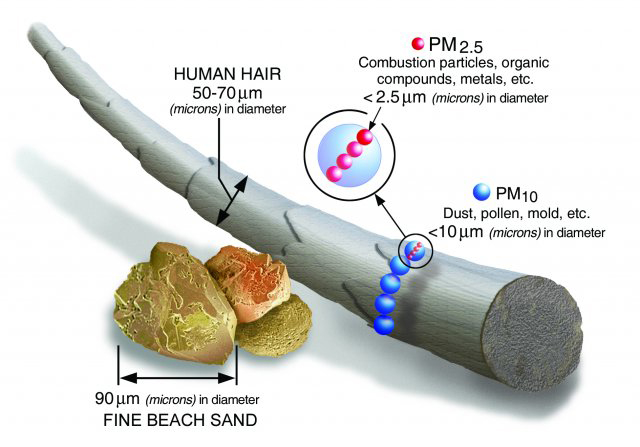
EPA wants to cut the annual levels of PM2.5 ― the very small particles of soot produced by fossil fuel combustion ― by as much as 25% from the current standard, which was set in 2012 and kept in place through 2020 by former President Donald Trump.
In a Notice of Proposed Rulemaking announced Friday, EPA said it plans to revise the annual National Ambient Air Quality Standards (NAAQS) from its current level of 12 micrograms per cubic meter (μg/m3) to 9 or 10 μg/m3.
The revised standard is “based on scientific evidence that shows the current standard does not protect public health with an adequate margin of safety, as required by the Clean Air Act (CAA),” the agency said in a fact sheet released with the 569-page NOPR.
PM2.5 is scientific shorthand for particulate matter with a diameter of 2.5 microns or less, which is about 30 times smaller than the diameter of a human hair and invisible to the human eye. “Most particles form in the atmosphere as a result of complex reactions of chemicals such as sulfur dioxide and nitrogen oxides, which are pollutants emitted from power plants, industries and automobiles,” according to information on EPA’s website.
“Long- and short-term exposures to PM2.5 can harm people’s health, leading to heart attacks, asthma attacks and premature death. Large segments of the U.S. population, including children and older adults, people with heart or lung conditions, and minority populations, are at risk of adverse health effects from PM2.5,” EPA said in the fact sheet.
The agency could also be considering revising the standard to as low as 8 μg/m3 or as high as 11 μg/m3, according to the announcement, which asks for comments on each of the proposed figures.
“Our work to deliver clean, breathable air for everyone is a top priority at EPA, and this proposal will help ensure that all communities, especially the most vulnerable among us, are protected from exposure to harmful pollution,” EPA Administrator Michael Regan said.
Doris Browne, former president of the National Medical Association, also stressed the equity and environmental justice impacts of the proposed new standards. “No one should be sickened by the environment they live in, and EPA’s proposal marks the start of changes that will have lasting impacts in communities all over, especially Black and brown communities that often experience increased PM pollution.”
According to the EPA, setting the annual standard at the lower 9 μg/m3 would prevent up to 4,200 premature deaths and 270,000 lost workdays per year. Overall public health benefits could total $43 billion by 2032, the agency said.
While focusing primarily on the annual PM2.5 standard, EPA said it will not propose revisions to the 24-hour standard for PM2.5, now set at 35 μg/m3, noting that “scientific evidence does not clearly call into question the adequacy of the current standard.” However, the agency does ask for comments on lowering the daily standard to 25 μg/m3.
The 24-hour standard for PM10, a somewhat larger form of particulate matter, would also stay unchanged at 150 μg/m3, EPA said.
Publication of the NOPR in the Federal Register will begin a 60-day comment period. EPA will also hold a virtual public hearing on the proposed standards at a date to be announced.
If a region’s air quality fails to meet the new standard, state governments must execute plans to meet the requirement.
“For PM2.5, such a plan could involve cutting car traffic by improving public transit or instituting carpool lanes. Or, if there are some industrial facilities like coal plants that do not have modern scrubbing technology, the state can compel them to clean up,” said Earthjustice’s Ben Arnoldy in a blog post.
A Compromise?
p.p1 {margin: 0.0px 0.0px 0.0px 0.0px; font: 11.0px ‘Helvetica Neue’; color: #000000}
The NOPR announcement is part of broader group of actions taken by EPA and the Biden administration, the agency said, pointing to the clean truck rules issued in December as one example. (See EPA Announces Tougher Emission Rules for Heavy-duty Vehicles.) While the proposed revisions would not directly target greenhouse gases, cutting PM2.5 from sources like power plants and cars could also result in lower carbon emissions.
EPA started setting standards for both PM2.5 and PM10 in 1971. According to the agency, the annual and 24-hour standards serve distinct purposes. The lower, annual standard provides protection against health impacts caused by short- or long-term exposure to PM2.5. The higher 24-hour standard is intended to protect against short-term exposures, particularly in areas that could experience high peaks in PM2.5 concentrations.
The EPA Green Book, which tracks compliance with a number of clean air standards, shows Pennsylvania with one county currently not in compliance with existing PM2.5 standards: Allegheny, in the western part of the state. California has 14 counties out of compliance: Fresno, Imperial, Kern, Kings, Los Angeles, Madera, Merced, Orange, Plumas, Riverside, San Bernardino, San Joaquin, Stanislaus and Tulare.
A revised standard of 9 μg/m3 could throw 112 counties, many in California, out of compliance, based on current reported emission levels.
The suggested standard of 9 or 10 μg/m3 appears to be a compromise between two options contained in a March 2022 report from EPA’s Clean Air Scientific Advisory Committee (CASAC).

A majority of committee members recommended the lower 8 μg/m3 standard, while a minority said the higher 11 μg/m3 would be sufficient. Similarly, the CASAC had a split decision on the 24-hour standard, with some supporting no change and others suggesting a cut to 25 to 30 µg/m3.
“There is substantial epidemiologic evidence from both morbidity and mortality studies that the current standard is not adequately protective. This includes three U.S. air pollution studies with analyses restricted to 24-hour concentrations below 25 µg/m3,” CASAC Chair Lianne Sheppard wrote in a letter introducing the report.
The nonprofit Clean Air Task Force cited CASAC in its statement, calling on EPA to go with the lower standards.
“An annual standard of 8 µg/m3 and a 24-hour standard of 25 µg/m3 would require more aggressive action under the Clean Air Act either by states or the federal government to address this problem in polluted areas,” said Hayden Hashimoto, associate attorney for the group. “Therefore, we will continue to urge EPA to set the standards at these levels, as it is critical for public health and the environment that they reflect the current scientific understanding of the threats posed by particulate matter.”
In response to the announcement, the Edison Electric Institute highlighted the industry’s emissions reductions to date and its intention to take an active role in discussions about any revisions to the standards.
Alex Bond, EEI’s deputy general counsel, said U.S. utilities have cut emissions of sulfur dioxide and nitrogen oxide 94% and 88%, respectively, since 1990, and now produce 40% of their power from “emissions-free sources, including nuclear energy, hydropower, wind and solar energy.”
EEI will work with EPA “to ensure that implementation of the standard is consistent with our industry’s ongoing clean energy transformation,” Bond said.
